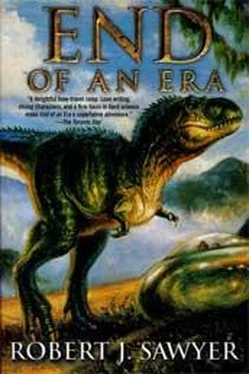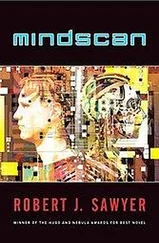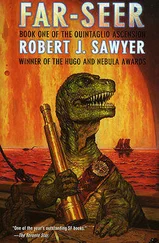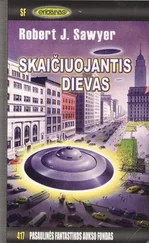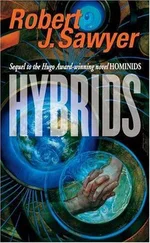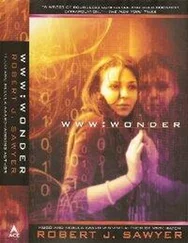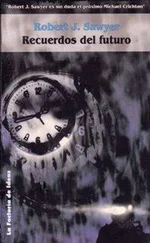Robert Sawyer - End of an Era
Здесь есть возможность читать онлайн «Robert Sawyer - End of an Era» весь текст электронной книги совершенно бесплатно (целиком полную версию без сокращений). В некоторых случаях можно слушать аудио, скачать через торрент в формате fb2 и присутствует краткое содержание. Год выпуска: 1994, ISBN: 1994, Издательство: Tor Books, Жанр: Фантастика и фэнтези, на английском языке. Описание произведения, (предисловие) а так же отзывы посетителей доступны на портале библиотеки ЛибКат.
- Название:End of an Era
- Автор:
- Издательство:Tor Books
- Жанр:
- Год:1994
- ISBN:0-312-87693-9
- Рейтинг книги:3 / 5. Голосов: 1
-
Избранное:Добавить в избранное
- Отзывы:
-
Ваша оценка:
- 60
- 1
- 2
- 3
- 4
- 5
End of an Era: краткое содержание, описание и аннотация
Предлагаем к чтению аннотацию, описание, краткое содержание или предисловие (зависит от того, что написал сам автор книги «End of an Era»). Если вы не нашли необходимую информацию о книге — напишите в комментариях, мы постараемся отыскать её.
century value and dinosaurs that behave very strangely. Could the slimy blue creatures from Mars have something to do with both?
End of an Era — читать онлайн бесплатно полную книгу (весь текст) целиком
Ниже представлен текст книги, разбитый по страницам. Система сохранения места последней прочитанной страницы, позволяет с удобством читать онлайн бесплатно книгу «End of an Era», без необходимости каждый раз заново искать на чём Вы остановились. Поставьте закладку, и сможете в любой момент перейти на страницу, на которой закончили чтение.
Интервал:
Закладка:
I thought about mentioning the missing crater to Klicks, but talk of meteor strikes always sparked the debate between us about whether one such had caused the Cretaceous-Tertiary extinctions. Klicks bought that theory. In the eyes of the general public, that made him right in line with mainstream thinking. After all, the newspapers and PBS shows in the 1980s had all concluded that an asteroid impact was indeed the culprit. I wasn’t in the mood to rehash it all again—I’m more inclined to lock horns with Klicks after a few brews, and, sadly, there were none among our provisions—but then something happened that brought up the old debate anyway. Slowly, quietly, without any fuss, a second moon was rising after the first. It was smaller, only about a third the apparent diameter of Luna. Spherical, it too was waxing gibbous, looking like a white jelly bean.
“Klicks?” I said.
“I see it.”
I brought my binoculars to bear on the tiny orb, but its face was too small to show any detail. “Trick,” I said, surprising myself. “I think we should call it Trick.”
“After Charles Trick Currelly, no doubt,” said Klicks, wanting to demonstrate that he got the reference. C. T. Currelly, an early-twentieth-century archaeologist, was the founder of the Royal Ontario Museum, where I worked. One of my occasional forays into the world of popular writing had been a biography of him for Rotunda, the ROM’s member magazine. Klicks did not dispute my choice of name and I was grateful for that small miracle.
We watched the two moons for some time. It seemed that Trick was catching up with Luna, meaning that it was in a much lower orbit. Since Luna is tidally locked, so that the same side always faces Earth, that would mean that Trick probably was also. It must be under a lot of gravitational stress being that much closer…
Aha!
“There goes the periodic extinction theory,” I said, excitement in my voice.
The Alvarez Group at Berkeley published their asteroid-impact extinction theory in Science in 1980. About the same time, an interesting hypothesis was making the rounds concerning the Eocene-Oligocene extinctions, the ones that would come 30 million years after the demise of the dinosaurs. According to it, those later extinctions resulted from a general cooling caused by the breakup of an ancient second moon, leaving Earth with a temporary equatorial ring of orbiting debris that blocked enough sunlight to lower temperatures for a million years or so. The Alvarez theory, sexy because it dealt with dinosaurs and embraced by many pop-science communicators after Sagan had linked it to nuclear winter, eclipsed the ringed-Earth discussions.
Others, including Klicks, tried to push the Alvarez theory a step further, claiming that bolide impacts at regular intervals, caused perhaps by a dark star periodically disturbing either the asteroid belt or the Oort cloud, were responsible for a regular schedule of extinctions, including both the K-T and the E-O. That idea never washed with me, since to get the 26-million-year periodicity you had to use the late Ordovician dyings, which were obviously just the result of plate tectonics moving the supercontinent Gondwanaland over the south pole, causing an ice age.
Klicks knew my position on all of that, of course, so I simply pointed at the second moon. “Trick provides a one-of-a-kind explanation for the Eocene-Oligocene extinctions,” I said. “There’s nothing periodic about a moon breaking up.”
To his credit, Klicks didn’t contest that. But he did say, “Why link it to those deaths? Why not to the ones that are about to occur?”
“Tektites,” I said, referring to the glassy, moon-like rocks found at various locations on Earth. “The age of the southeastern U.S. tektite field coincides with the E-O boundary. I bet they were caused by the impacts of the remnants of Trick.”
Klicks was quiet for a minute or so, although I could hear him grinding his teeth in the dark, the way he does when he’s thinking—chewing over a problem, you might say. Finally he spoke. “We have sleeping pills.”
“Huh?” I guess the change of subject meant I had won that round, but I couldn’t see what he was getting at.
“I said, we could take something to get to sleep. We’re going to be useless in the morning if we stay awake all night.”
I never took sleeping pills. I knew I had an addictive personality—another one of Dr. Schroeder’s little insights. That meant messing with any drug would be out of the question for me. Hell, I have a hard enough time avoiding pizza, and Schroeder swears that there’s nothing in the old double-cheese-and-pepperoni that could cause a chemical dependency. Still, what Klicks said made sense. I could hear him moving around the dark cabin. When he opened our medicine refrigerator a small yellow bulb came on, illuminating its interior. Klicks found the bottle he was looking for and, leaving the door open so that he’d have some light, went to the sink and filled a couple of paper cups. We had more than enough water in the tank beneath our feet to last the eighty-seven hours we would be here, that being the maximum length of time the Huang Effect could hold a lock on us when casting this far back.
“Here,” he said, offering me one of the Dixie cups and a silver caplet. I slipped the pill into my breast pocket. Klicks kicked the fridge door shut and all was darkness for a moment, until he turned the overheads back on, their brightness making us both squint. He turned the crank on the side of his crash couch, and it ratcheted around from its normal sitting configuration into a flatbed position.
I moved away from the window, from the odd spectacle of Trick slowly chasing Luna through the forest of stars, and converted my couch to sleeping mode, too.
Next, I changed into my pajamas. While doing so, my eyes kept being drawn out the window to the sight of the two moons. Even if the existence of Trick disproved the periodic extinctions theory, I was sure Klicks would stick to the asteroid model for the death of the dinosaurs.
It’s frustrating being a paleontologist. My neighbor Fred—the one with the dead cat—once said to me, hey, now that they know what killed the dinosaurs, guess your job is pretty much over. That seems to be the public’s attitude. But, really, it’s all because a couple of astronomers and physicists who knew nothing about dinosaurs and a couple of glib talkers from the paleontological community who wanted some limelight pushed the idea so vigorously that it got, quite literally, more popular-press coverage than any scientific theory since World War II.
But it’s just a theory, and not a very good one at that. Yes, there’s no longer much doubt that there was an impact of a ten-kilometer-wide asteroid at or near the end of the Mesozoic. But the Mesozoic lasted 160 million years, and during it there were at least seven other large-asteroid impacts. Each is at least as well documented as the supposed dinosaur-killer (one formed the 100-kilometer-wide Manicouagan crater in Quebec), and there’s zero turmoil in the fossil record associated with any of them.
It’s what Bob Bakker calls the frog problem: frogs, notoriously sensitive to climactic change, survived the end of the age of dinosaurs just fine, but big animals, which should have had more resistance, were all killed off. An asteroid impact is the wrong sort of scenario to explain the selective extinctions we see in the fossil record.
Sure, there’s a buried crater called Chicxulub half on land and half beneath the sea near the northern coast of Yucatan, Mexico. And, yes, by the early 1990s, a series of tests had dated it to very close to the K-T boundary. But with so many confirmed and possible Mesozoic craters, it surprised me that the impact-extinction theory continued to have any legs. Beside Chicxulub and Manicouagan, the later dated at 214 million years before the time I’d been in when I’d woke up this morning, there’s also the 175-million-year-old Puchezh-Katunki crater in Russia, the 145-million-year-old Morokweng crater in South Africa, the 144-million-year-old Mjolnir in the Barents Sea, the 128-million-year-old Tookoonooka in Australia, the 117-million-year-old Carswell in Saskatchewan, and the 74-million-year-old Manson in Iowa. I mean, heck, if large bolide strikes really did have staggering biological effects, we’d have seen a constant series of massive extinctions throughout the age of dinosaurs; it’d be a wonder that the terrible lizards had survived as long as they did.
Читать дальшеИнтервал:
Закладка:
Похожие книги на «End of an Era»
Представляем Вашему вниманию похожие книги на «End of an Era» списком для выбора. Мы отобрали схожую по названию и смыслу литературу в надежде предоставить читателям больше вариантов отыскать новые, интересные, ещё непрочитанные произведения.
Обсуждение, отзывы о книге «End of an Era» и просто собственные мнения читателей. Оставьте ваши комментарии, напишите, что Вы думаете о произведении, его смысле или главных героях. Укажите что конкретно понравилось, а что нет, и почему Вы так считаете.
